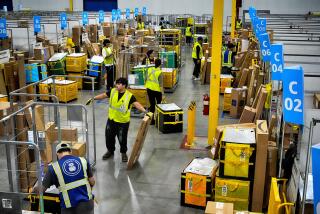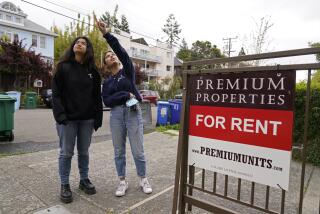2nd-Quarter Figure for GDP Revised
- Share via
WASHINGTON — A cooling housing market helped slow economic growth in the second quarter more than was earlier estimated and may curb expansion for the rest of the year, the government reported Thursday.
With November congressional elections on the horizon, a top White House official played down worry about a lasting broad-based slowdown. But some analysts said weaker home sales, prices and construction activity cast a shadow over longer-term prospects.
Gross domestic product, which measures total economic activity within the United States, advanced at a revised 2.6% annual rate in the second quarter, down from the 2.9% estimated a month ago, the Commerce Department said.
That was less than half the first quarter’s 5.6% rate.
The GDP report underlines how a cooling housing sector is affecting the overall economy. Investment in residential structures tumbled at the sharpest rate in more than a decade -- down at a revised 11.1% rate instead of the 9.8% reported a month earlier.
It was the third straight quarter in which spending on new housing declined and department officials said it was the biggest quarterly drop since a 12.2% fall in the second quarter of 1995.
The chairman of the White House Council of Economic Advisers, Edward Lazear, acknowledged the effect of softer housing during an appearance before the Senate Budget Committee.
“It appears that the housing slowdown will be a significant drag on third-quarter growth,” Lazear said. “It is important to note, however, that the weakness in the housing sector does not seem to be spreading to other sectors of the economy.”
There was some evidence of the housing sector’s limited spillover in a separate report from the Labor Department.
New claims for unemployment pay dipped 6,000 last week to a seasonally adjusted 316,000, a level economists consider a healthy hiring environment.
However, a third report from the Conference Board, measuring the number of help-wanted ads in U.S. newspapers, suggested that companies were not rushing to add to payrolls. Its help-wanted index dropped to a 45-year low 31 in August from 32 in July.
The Federal Reserve in August suspended a cycle of interest-rate rises that it had initiated in mid-2004 and some analysts think it may cut rates early in 2007 if the housing slump deepens.
“The housing issue is a bigger issue than many will give credit and we think GDP will be soft for longer than anyone expects,” said Robert Lutts, chief investment officer for Cabot Money Management in Salem, Mass.
The GDP report showed inflation bubbling higher.
A price gauge favored by the Fed -- personal spending excluding food and energy items -- rose at a revised 2.7% rate instead of the 2.8% reported a month earlier. That topped the first quarter’s 2.1% and was the highest since 2.8% in the first quarter of 2001.
The GDP report said corporate profits barely grew by a revised 0.3% in the second quarter rather than the 2.1% the Commerce Department estimated a month ago. That was a steep plunge from a 14.8% rate of profit growth in the first three months of this year.
The government’s picture of earnings growth contrasts sharply with other measures of corporate profits.
Among members of the Standard & Poor’s 500 index, made up of the 500 largest publicly traded U.S. companies, earnings in the second quarter rose nearly 4.4% from the first quarter and were up 13.3% from the year before.
More to Read
Get the L.A. Times Politics newsletter
Deeply reported insights into legislation, politics and policy from Sacramento, Washington and beyond. In your inbox three times per week.
You may occasionally receive promotional content from the Los Angeles Times.










